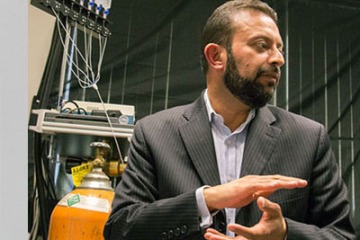UArizona Health Sciences Researchers Seek to Treat Pain Caused by Chemotherapy Without Opioids
UArizona Health Sciences Start-up Company Regulonix Receives Grant as Part of NIH “Helping to End Addiction Long-Term Initiative” (NIH Heal Initiative).

Researchers at the University of Arizona Health Sciences are making progress in an effort to develop an effective treatment for neuropathic pain caused by chemotherapy — without using opioids.

Rajesh Khanna, PhD, hopes to develop non-opioid painkillers for cancer patients, who often suffer from pain in their hands and feet. (Photo: Kris Hanning)
Rajesh Khanna, PhD, professor of pharmacology at the University of Arizona College of Medicine – Tucson, said chemotherapy-induced peripheral neuropathy (CIPN) — a result of damage to the nerves outside of the brain and spinal cord — is detected in 64% of cancer patients during all phases of cancer, but no effective treatment exists. Chemotherapy remains a frontline treatment for many forms of cancer, but often causes severe side effects, including CIPN.
In response, Dr. Khanna and his research team are developing “potent and selective T-type calcium channel antagonists” as potential novel pain medicines to treat CIPN. Their goal is to provide pain relief to cancer patients, increase their compliance of chemotherapy and improve their well-being, he said.
Dr. Khanna also is scientific co-founder of Regulonix, LLC, a UArizona Health Sciences start-up company that received a $341,528 grant from the National Institutes of Health as part of the “Helping to End Addiction Long-Term Initiative” (NIH HEAL Initiative), launched in 2018 to improve prevention and treatment strategies for opioid misuse and addiction and to enhance pain management.
Chemotherapy-induced peripheral neuropathy is detected in 64% of cancer patients, but no effective treatment exists.
Dr. Khanna, principal investigator of the study, said it represents the first step in developing non-opioid pain treatments for chemotherapy-induced peripheral neuropathy. Jun Wang, PhD, assistant professor in the Department of Pharmacology and Toxicology in the UArizona College of Pharmacy and a member of the UArizona BIO5 Institute, is a key collaborator on this study and created the original compounds that led to development of the compound being tested, which is called “UAWJ111.”
Although initial results in rodent models have been promising, the research is in its very early stages, Dr. Khanna cautioned, adding the team also seeks to determine if the new compound has significant side effects and potential for abuse — and whether it also might be effective for other types of pain.
“It’s clear that a multi-pronged scientific approach is needed to reduce the risks of opioids, accelerate development of effective non-opioid therapies for pain, and provide more flexible and effective options for treating addiction to opioids,” said NIH Director Francis S. Collins, MD, PhD, who launched the initiative. “This unprecedented investment in the NIH HEAL Initiative demonstrates the commitment to reversing this devastating crisis.”
Our Experts
Contact
Health Sciences
Office of Communications
520-626-7301
public@arizona.edu

